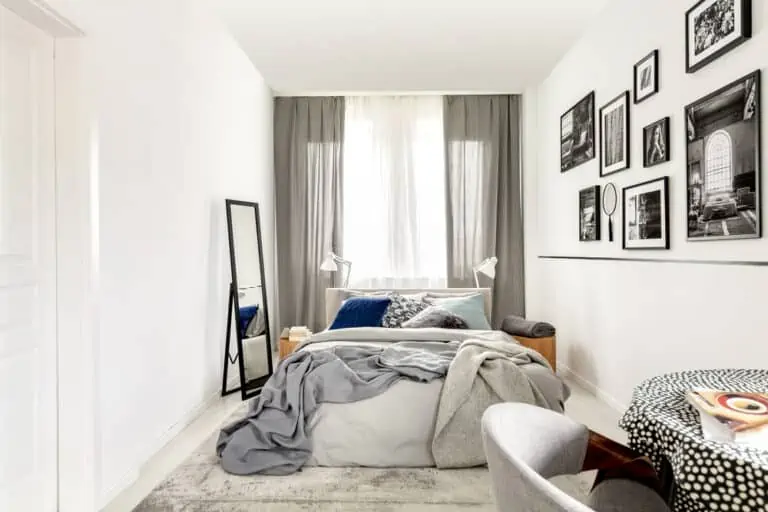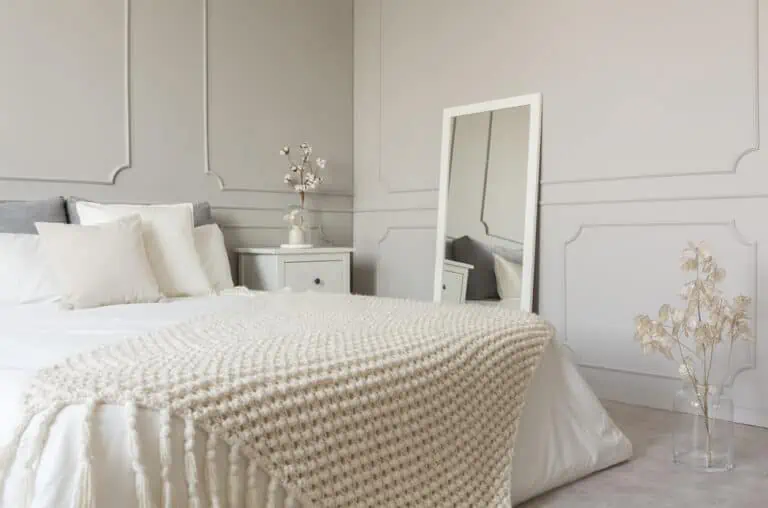Should Your Nightstands Match? Expert-Approved Rules for Perfect Bedroom Harmony
Homebody Forever is reader-supported. We may receive a commission if you make a purchase through a link on this post.
Decorating your bedroom is a fun experience, but can come with difficult decisions. What look are you going for? How do you make it cozy but still clean and free from clutter? Do nightstands have to match?
The short answer is, not necessarily. You do whatever works for your bedroom and aesthetic.
But there are a few design principles you might want to consider if you like the harmonious look.

Benefits of Matching Nightstands
Aesthetic Appeal
Let’s start with the first reason why you might want matching nightstands. It looks good. That’s it.
It creates a sense of cohesion, making your space look more put-together.
Especially if you get a pair of nightstands that matches whatever else you already have in your bedroom, like your bed frame, color scheme, bedroom furniture or overall style.
Balance and Symmetry
Adding matching bedside tables creates balance and symmetry in your bedroom layout. This is not only aesthetically pleasing, but also contributes positively to the overall ambiance and energy in the space.
A balanced bedroom can promote relaxation and help you feel more comfortable in your personal sanctuary. There’s a reason why spas and wellness centers don’t opt for haphazard maximalist decor.
Easy Coordination
When you have matching nightstands, coordinating your bedroom decor becomes much easier.
With matching pieces, you won’t have to spend too much time searching for the perfect complementary items because you just get two of everything (if you want a symmetrical look).
This saves you time and energy, which allows you to focus on other aspects of your bedroom design.
Timeless Elegance
Nightstands that much often exude a sense of timeless elegance, giving your bedroom a classic, sophisticated feel.
Whether you choose traditional or contemporary designs, matching nightstands can act as statement pieces that elevate your bedroom’s decor.
Consistency in Function
Identical nightstands will have the same storage capacity and features, making it easy to organize and access your belongings on both sides of the bed.
If you share a bed with a partner, you can have your own display and storage space.
Trust me, this makes all the difference when it comes to a peaceful bed time routine (I speak from experience), and if you have a partner that has the tendency to accumulate more stuff than you (which I also know a thing or two about…)
Reasons for Mismatched Nightstands
This section will explore why you might consider having non-matching nightstands in your bedroom.
Personal Style
One reason to have mismatched nightstands is to express your unique personal style. Mixing and matching different pieces can create a dynamic and visually interesting space.
This approach allows you to showcase your creativity and design preferences. Here are some examples:
- Pair a minimalist, modern nightstand with a vintage, ornate one to create a fun design contrast.
- Combine nightstands made from different materials, such as wood and metal, to add texture to your bedroom.
- Choose nightstands in varying heights or shapes to create a more eclectic look.
Space Constraints
Another reason to opt for mismatched nightstands is to address space constraints in your bedroom. Every room is unique and may have specific spatial requirements that matching nightstands cannot accommodate.
Mix and Match Tips
In this section, we’ll explore the art of mixing and matching nightstands to create a unique and cohesive look for your bedroom.
You don’t have to choose matching nightstands to achieve a stylish and functional space. Let’s dive into some tips on playing with height, material, and texture.
Playing with Height
Using nightstands of varying heights can add interest and depth to your bedroom design. To achieve a balanced look, consider the following:
- Choose nightstands with a height difference of no more than 6 inches.
- Ensure the height of the nightstands works well with the height of your bed and other furnishings.
- For visual harmony, try pairing a taller nightstand with a shorter table lamp or vice versa.
Material
Experimenting with different materials for your nightstands can also introduce texture and contrast to your bedroom. Here are some ideas:
- Pair a wooden nightstand with a metal or glass one for an industrial feel.
- Combine materials like marble and brass for a touch of elegance.
- For an eclectic look, consider nightstands made from reclaimed or repurposed materials.
Texture
Playing with texture can add dimension to your bedroom, making it feel more inviting and cozy. Consider these tips when selecting nightstands with different textures:
- Use a nightstand with a textured surface, like rattan or shagreen, alongside one with a smooth, sleek finish. Read tips about protecting your nightstand top here.
- If you have a soft, upholstered bed, choose a nightstand with a contrasting, hard material such as wood or metal.
- For a minimalist look, keep textures subtle and complementary, such as pairing a smooth wooden nightstand with a slightly textured one.
By experimenting with height, material, and texture, you can create a unique and curated look for your bedroom with non-matching nightstands.
Final Thoughts
There’s no hard and fast rule when choosing the perfect bedside furniture.
While having matching nightstands can help you achieve the sense of calm and tranquility you’re after, mixing and matching allows you to exercise your creativity and add a unique and personal touch.
Ultimately, your bedroom should be a reflection of your personality and taste. And of course, you don’t want to sacrifice comfort in the process.
Take these tips as inspiration and guidelines, but remember that when it comes to your space, the only rule you should follow is to do what allows you to feel good.



